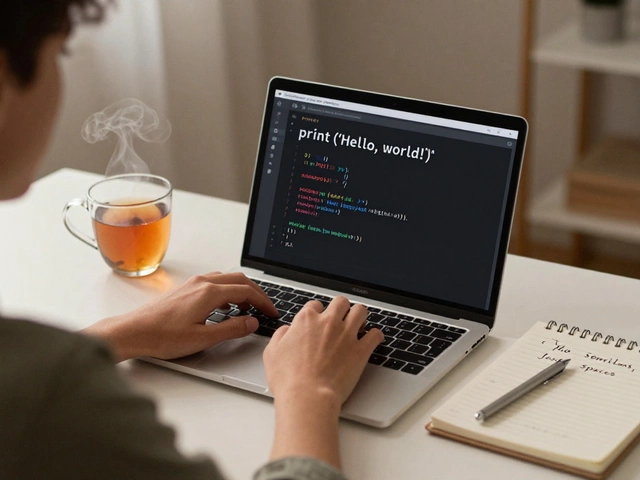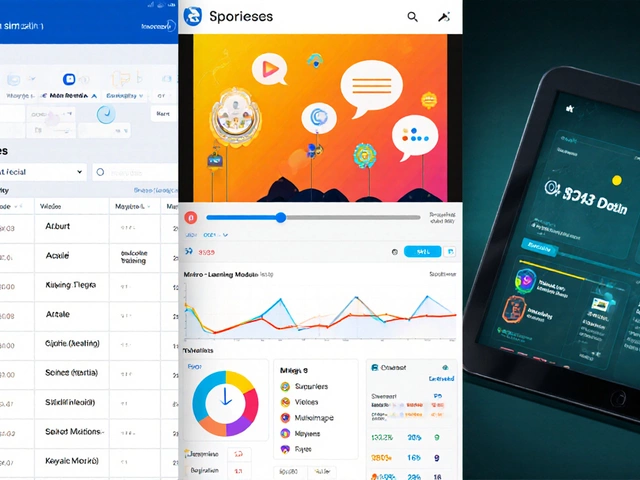In the world of coding, there's a principle that seasoned developers swear by: the golden rule of coding. It's a guidepost that points to a truth often forgotten in the excitement of solving complex problems — that clarity trumps cleverness. Too often, programmers dive deep into creating intricate webs of logic that, while ingenious, become impossible for others to untangle. This rule advises coders to keep their work straightforward, ensuring it's easily readable and maintainable.
Embracing the golden rule isn’t just about writing tidy code for its own sake. It's about creating programs that others can build upon, debug, and improve without tearing their hair out. By sticking to simplicity and readability, you're doing future-you, and any collaborators, a significant favor. Simple guidelines, like keeping functions purpose-specific and naming variables clearly, not only elevate the quality of your work but also foster healthier collaboration within teams.
- The Essence of the Golden Rule
- Benefits of Simple and Readable Code
- Common Mistakes to Avoid
- Practical Tips for Writing Better Code
The Essence of the Golden Rule
The golden rule of coding might be best summed up in a philosophy that transcends individual languages and trends: write code that gets easily understood by human beings. It speaks to a truth that distinguishes veteran programmers from the newcomers; coding isn't just about instructing computers but communicating with the future team members who will read, edit, and expand on your work. It's about composing text that stands the test of time in both function and form, allowing for seamless transition from one programmer to another, saving time, reducing errors, and enhancing productivity.
At its heart, this principle is about readability. Just like a good book doesn’t force readers to decipher cryptic prose, well-written code should convey clarity and precision with every line. Respected computer scientist and author, Martin Fowler, once said,
"Any fool can write code that a computer can understand. Good programmers write code that humans can understand."This perspective challenges the mindset of seeing coding as a mere technical task. Instead, it encourages programmers to see their work as a significant piece of art, one that offers simplicity in its elegance—achieving functionality without unnecessary complexity.
A pivotal part of practicing the golden rule involves understanding the impact of programming styles on maintainability. Imagine jumping into a six-month project where the previous developer left a bewitching code labyrinth, with variables named ‘x’ or ‘xxz’ and functions stacked with layers of unpredictable logic. That might delay project progress. By adhering to sound naming conventions and clear documentation, the chaotic syntax untangles itself, revealing pathways for logical continuity and seamless development. Keep it human-readable, and you solidify a project’s foundation for future advancements.
One must acknowledge that simplicity doesn't mean sacrificing the complexity required for sophisticated problem-solving. Rather, it’s about presenting complexity in digestible bits. Modern software development increasingly relies on collaborative efforts, and writing clear, concise, and well-documented code doesn't only benefit the original coder. It's vital for integrating contributions from colleagues, maintaining code years after its initial launch, and avoiding common pitfalls that project bloat and technical debt can bring to a team. All the while, the golden rule of coding promotes efficiency across software development, emphasizing this delicate balance between clarity and functionality.
Intrinsic to this principle is the avoidance of 'clever' coding tricks, which might seem brilliant in the moment but often lead to regret when debugging arises. Being flashy might cater to the ego now, but patience and precision are the virtues that support long-term software sustainability. Instead of embedding hidden complexities, the golden rule advises transparency. After all, while the intricate, knotted code might work for the moment, it’s the well-orchestrated lines that stand resilient against technological tides.
Programmers should also consider user design principles when writing code. Just like a software interface, the code written should guide the reader intuitively from beginning to end. Using comments judiciously, adhering to standard coding structures, and sectioning off well-explained parts can guide someone through understanding quickly and efficiently. Mastering these aspects of best practices fosters an environment where both innovation and maintenance can thrive optimally. By observing the golden rule, you are not merely contributing to present objectives but also paving a clear path for future achievements.

Benefits of Simple and Readable Code
When diving into the art of coding, it's easy to get lost in the complexity of logic and forget the key to successful projects: simplicity and readability. Simple and readable code is essential not just for the individual programmer, but for the entire team and project longevity. Firstly, code readability significantly reduces the time and effort required during code review processes. Colleagues and fellow developers can grasp the functionality and logic more efficiently when code is straightforward. This accelerates the development process, promotes better software development practices, and reduces the chance of introducing errors during updates. Maintaining simple code means future modifications or adaptations become less of a headache, making the team's workflow smoother.
Furthermore, leveraging readable code fosters better communication within a programming team. When every team member adheres to these principles, understanding and collaboration improve drastically. It allows developers to focus less on deciphering the code and more on innovating new features. John Carmack, the legendary programmer known for his work on Doom and Quake, once noted,
"The competent programmer is fully aware of the strictly limited size of his own skull; therefore he approaches his task with full humility, and avoids clever tricks like the plague."This reflects how prioritizing readability fosters an environment where efficient communication becomes the norm.
There’s also a direct impact on software performance. While complex algorithms might look impressive on paper, they often lead to convoluted execution paths that consume more resources than necessary. A codebase that's easy to read usually results in faster execution and optimized resource utilization, enhancing the overall system performance. Consider a scenario where you inherit a project from a colleague. If the code is neat and understandable, the onboarding is faster, enabling quicker delivery of features or bug fixes. In a study conducted by the IEEE, properly organized and readable code bases were found to decrease debugging time by up to 50%, improving turnaround times and decreasing project costs.
Moreover, simplicity means scalability. Software frequently requires scaling. Whether you're expanding on features or accommodating increased user loads, readable code makes the transition seamless. The initial investment in writing clean code pays off significantly during scaling phases. This approach saves not only time but financial resources as well. Lastly, readable code provides a valuable teaching tool for budding programmers. It stands as a real-world example of best practices, setting them on a path to become skilled programmers. Easy-to-understand codebases help newcomers grasp concepts quickly, flattening the learning curve and providing tangible insights into effective programming.

Common Mistakes to Avoid
Coding is as much an art as it is a science, and novice programmers often stumble into similar pitfalls. One common mistake is the tendency to overcomplicate solutions, losing sight of the golden rule of keeping things simple. This complexity not only makes the code harder to read, but it also becomes a breeding ground for bugs. Developers should resist the urge to show off their skills with overly clever tricks or convoluted algorithms; clarity is king. Another frequent issue is neglecting comprehensive commenting. Code can become quite cryptic over time, and without clear comments, even the original author can struggle to recall why certain decisions were made. Embracing solid documentation is crucial for sustainable software development.
Poor variable naming is another trap many fall into, and it severely impacts code readability. Opting for concise, yet descriptive names helps both the original coder and any others who may take over the project. For example, instead of x or y, naming a variable currentBalance or itemCount lends itself to immediate understanding. Similarly, ignoring proper formatting and indentation can lead to error-prone, unreadable blocks of code. Using consistent naming conventions and spacing practices ensures the codebase remains organized and visually accessible. An oft-repeated reminder from seasoned developers: 'Code as if the person who ends up maintaining your code is a violent psychopath who knows where you live.'
Additionally, failing to plan out a project thoroughly before diving into the code can lead to a tangled mess that's difficult to unravel. Crafting a clear roadmap, which includes outlining the basic structure and flow of the application, can save a tremendous amount of time and rework. A lack of modularity is another mistake, where coders try to accomplish too much within a single function or method. This goes against the strong principles of maintaining simplicity and can make debugging a nightmare. Instead, break down tasks into smaller, manageable chunks that can be reused and tested individually.
Often overlooked, skipping regular testing is another grave error. Many delay testing until they believe the program is complete, which can result in undiscovered bugs lurking in their codebase. Writing small tests for individual components and running them frequently, also known as unit testing, can catch issues early. Alongside this, ignoring version control systems, like Git, can lead to irreversible errors or data loss. Using such tools not only helps track changes but also facilitates collaboration and rollbacks when necessary.
"Testing is the responsibility of everyone involved, and effective testing strategies can truly make or break a project," says Martin Fowler, a well-regarded software development expert.

Practical Tips for Writing Better Code
Creating remarkable software doesn't just rest upon the shoulders of logic and algorithms; it leans heavily on how you program those creative solutions. Here, we'll delve into some deeply effective practices that can transform how you code. Let's kick off with the basic, yet powerful idea of keeping your functions focused. Each function should perform a single task, making it easier to test and troubleshoot. This approach not only reduces complexity but also elevates readability. When someone else — or even you, months later — reads your code, they can quickly understand what each part does without a line-by-line dissection.
Avoid the allure of clever code. It might feel satisfying, almost like solving a puzzle, but it often becomes a nightmare during maintenance. Simple, straightforward code is less error-prone, easier to debug, and most importantly, simpler for others to follow. Here's a little wisdom from renowned software engineer Martin Fowler:
"Any fool can write code that a computer can understand. Good programmers write code that humans can understand."This mantra underscores the importance of human-readable software development.
Power of Naming Conventions
The significance of naming conventions can't be overstressed. A variable named 'temp' might mean little out of context, but 'temperatureInCelsius' provides instant clarity. This isn't just a nod to formalities — clear naming conventions in your coding endeavor help others quickly grasp your logic and avoid costly misunderstandings. Get into the habit of using descriptive names, even if they are longer, as the added readability offers substantial payoffs during collaboration.
Documentation: The Unsung Hero
Documentation might seem monotonous, especially when your programming flow is in full swing. Yet, it acts as a bridge between different stages of project evolution and among team members. Writing comprehensive comments, maintaining clear documentation, and assigning time for this important task might feel cumbersome, but they ultimately save countless hours. The trick is to explain why the code works the way it does, not just what it does, so future developers can appreciate and utilize your insights.
Consistent Code Style
Maintaining consistency in your code style can seem trivial but it fosters a professional environment. Whether you decide on specific indentation sizes, brace placements, or even naming schemes, stick to them religiously. Imagine a scenario where every coder in a team of twenty does their own thing; chaos quickly ensues. By ensuring team adherence to a coding style guide, modifications and reading become seamless parts of the process, rather than frustrating ordeals. This uniformity makes it easier for developers to shift between different projects without constantly having to adapt to new styles.
Programming with these tips in mind not only enhances productivity but also leads to durable, reliable, and functionally stellar projects. Your commitment to small, continuous improvements in your approach will craft you into a developer that others look up to. Keeping learning alive is vital; the field evolves rapidly, and staying current will always give you an edge. Remember, great code doesn't happen by accident — it's carefully planned and built, brick by brick.













